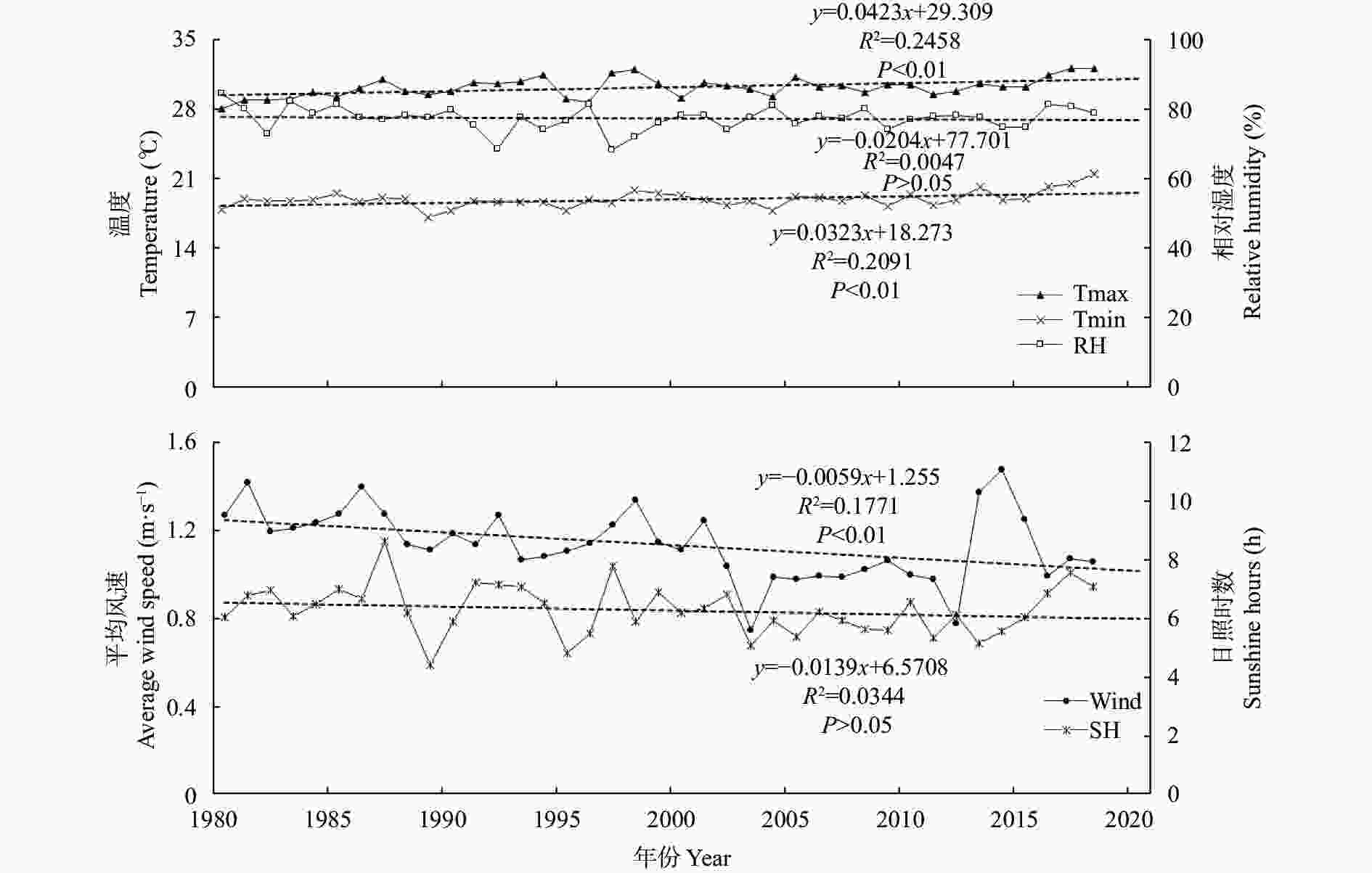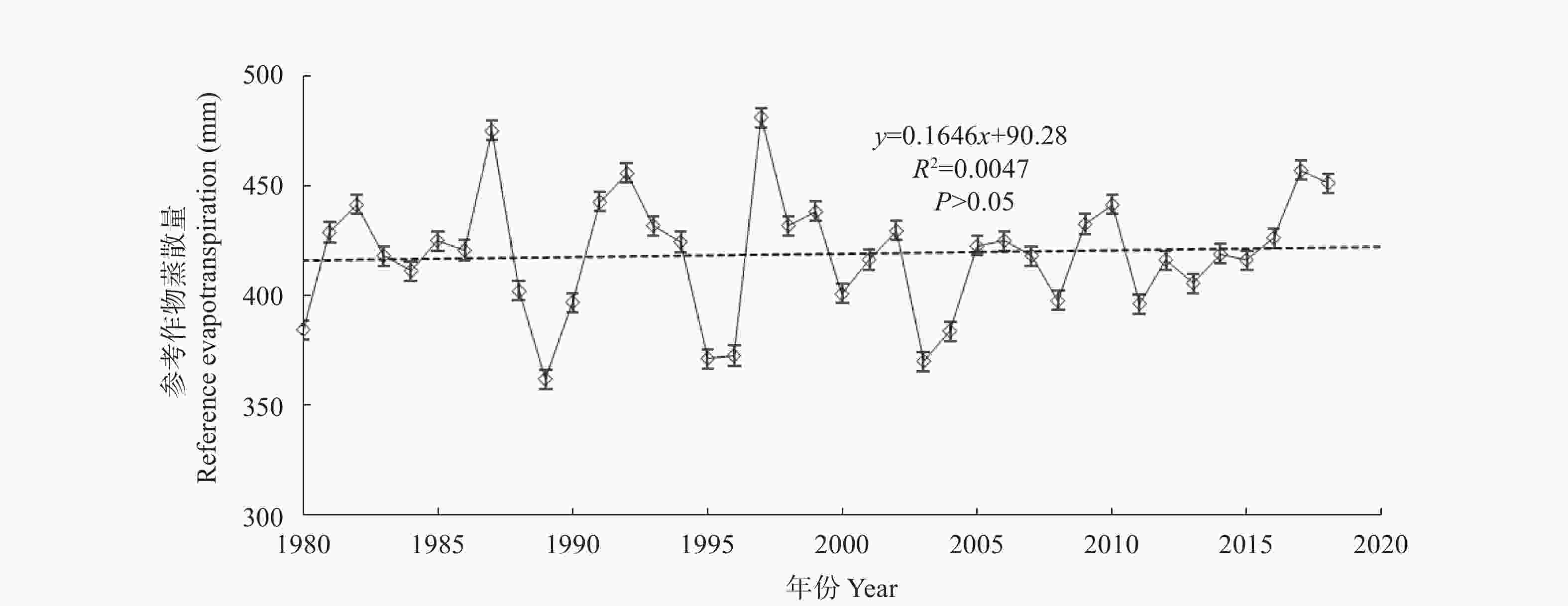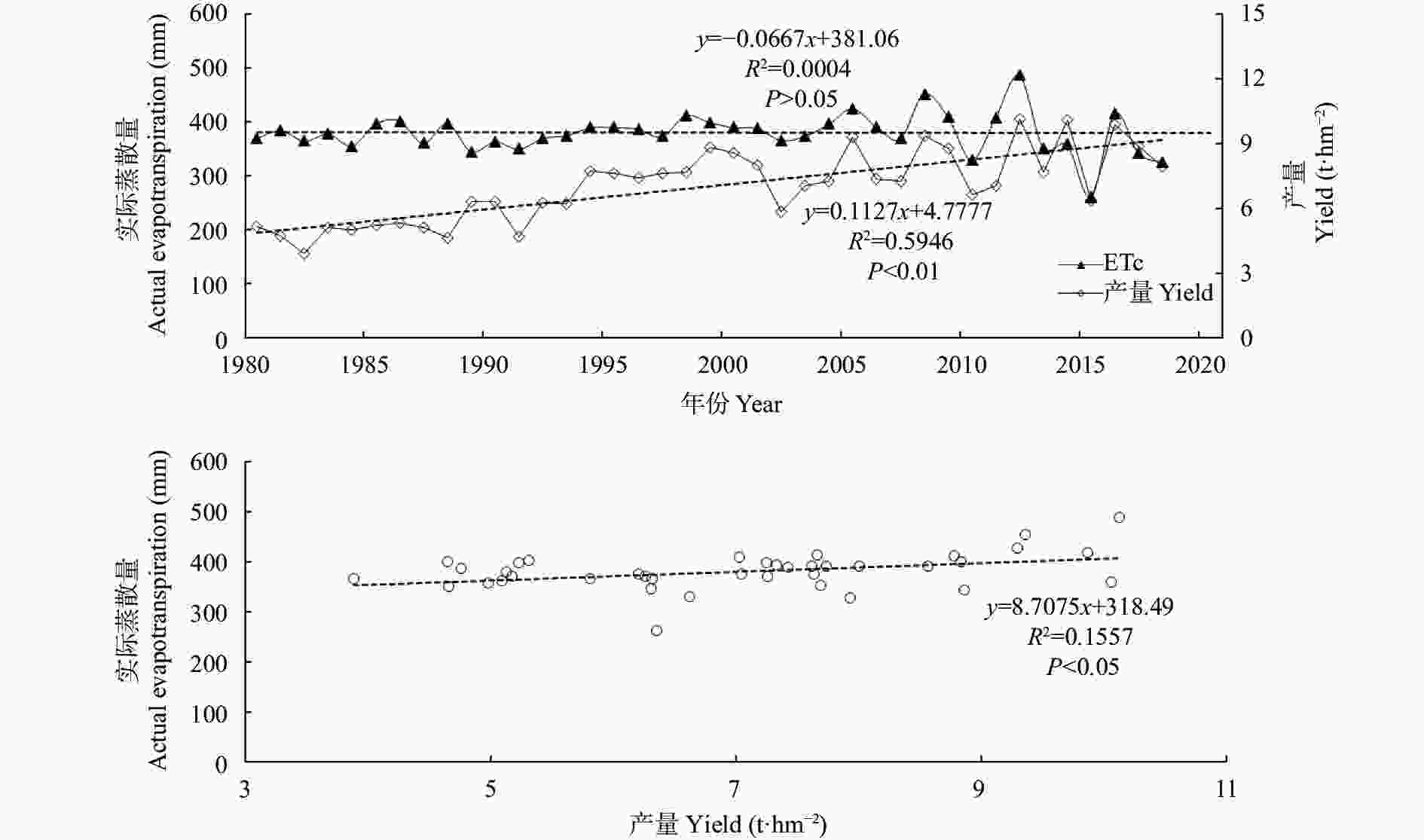Changes and influencing factors of crop coefficient of summer maize during the past 40 years in the North China Plain
-
摘要: 作物系数(作物实际蒸散量与参考作物蒸散量之比, Kc)作为农田需耗水确定的关键参数, 对农业精准灌溉和节水具有重要的参考价值。研究作物系数如何受生产条件和气象条件变化的影响, 可为准确确定作物系数提供依据。本研究基于中国科学院栾城农业生态系统试验站1980—2018年充分灌溉条件下夏玉米作物系数变化规律及影响因素, 利用2019—2021年夏玉米不同灌水处理下的试验数据, 确定不同供水条件下夏玉米作物系数的计算方法。结果表明, 1980—2018年参考作物蒸散量(ETo)基本保持稳定, 但存在年际波动。充分供水条件下夏玉米实际蒸散量(ETc)在2005年之前保持年际间稳定, 近年来年际间波动幅度较大。作物实际蒸散量与参考作物蒸散量之比的作物系数多年平均值为0.91, 年际变异系数为12.36%。作物系数受作物产量和大气条件影响, 产量的增加伴随着夏玉米实际蒸散量的增加, 参考作物蒸散量主要受平均风速和日照时数的影响。分析表明作物系数由参考作物蒸散量和实际蒸散量共同决定, 且受夏玉米实际蒸散量的影响较大。灌水量的差异是造成相同年份不同处理间差异的主要因素。利用缺水处理下土壤水分状况和不同土层相对根长密度计算土壤水分胁迫系数, 结果表明使用缺水灌溉处理的土壤有效水分含量对夏玉米作物系数进行校正, 所得值与实际值最为接近, 可根据计划控制的土壤水分状况调整作物系数, 确定不同控水条件下的农田实际耗水量。Abstract: As a key parameter for determining crop water consumption, accurate estimation of the crop coefficient (Kc) is important for irrigation scheduling. Kc is influenced by changes in production and meteorological conditions. This study analyzed Kc changes from 1980 to 2018 for summer maize under sufficient water supply based on long-term field experiments at the Luancheng Agro-Ecosystem Experimental Station of the Chinese Academy of Sciences. Using data of the three most recent seasons from 2019 to 2021 for maize under normal and water-deficit conditions, the calibration coefficient of Kc by soil water content was developed and tested. The results showed that the reference crop evapotranspiration (ETo) was stable from 1980 to 2018; however, seasonal fluctuations were observed. The actual evapotranspiration (ETc) of summer maize under adequate water supply conditions has substantially changed over recent years. The multiyear average Kc for maize was 0.91, and the interseasonal variation coefficient was 12.36%. Kc is affected by crop yield and atmospheric conditions. An increase in yield was accompanied by an increase in the ETc of summer maize. ETo was mainly affected by average wind speed and sunshine hours. Our analysis revealed that Kc is determined by ETo and ETc and is greatly affected by the ETc of summer maize. For the three most recent seasons, the difference in irrigation quantity was the main factor causing differences in Kc among the different treatments in the same season. Kc adjustment using different methods considering the soil water content could be used to estimate ETc. Incorporating the root length distribution factor into the soil water status for Kc adjustment provided a better estimate of ETc using the crop coefficient method. Therefore, Kc can be adjusted according to the root-zone soil moisture status to determine the actual crop water consumption.
-
Key words:
- Summer maize /
- Crop coefficient /
- Full irrigation /
- Deficit irrigation /
- Water stress coefficient
-
图 1 1980—2018年夏玉米生长季气象因素年际变化
Tmax: 最高空气温度; Tmin: 最低空气温度; RH: 相对湿度; Wind: 2 m处平均风速; SH: 日照时数。Tmax represents the maximum air temperature, Tmin represents the minimum air temperature, RH represents the relative humidity, Wind represents the average wind speed at 2 m, and SH represents the sunshine hours.
Figure 1. Variation of meteorological factors during the growth seasons of summer maize from 1980 to 2018
图 8 2019—2021年根据不同水分胁迫系数计算所得夏玉米不同生育期实际蒸散量
ETc为实测实际蒸散量; ETc1、ETc2、ETc3和ETc4分别表示根据水分胁迫系数Ks1、Ks2、Ks3和Ks4计算所得实际蒸散量, Ks1、Ks2、Ks3和Ks4为4种不同计算方法所得水分胁迫系数。Ini为生育初期, Dev为快速发育期, Mid为生育中期, End为生育末期, Total为全生育期。ETc represents the measured actual evapotranspiration. ETc1, ETc2, ETc3 and ETc4 represent the actual evapotranspiration calculated by Ks1, Ks2, Ks3 and Ks4, respectively. Ks1, Ks2, Ks3 and Ks4 represent the water stress coefficients calculated by four methods. Ini represents initial stage, Dev represents developing stage, Mid represents middle stage, End represents end stage, and Total represents whole growth stage.
Figure 8. Actual evapotranspiration during different growth stages of summer maize calculated from 2019 to 2021 according to different water stress coefficients
表 1 1980—2021年长期定位灌溉试验期间夏玉米品种及施肥量变化
Table 1. Changes of cultivar and fertilization rate of summer maize in the long-term irrigation experiment from 1980 to 2021
时期
Period栽培品种
Cultivar两季作物总施肥量
Total fertilizer use
amount of two season crops施肥管理
Management of fertilizer application20世纪80年代
1980s单杂交品种
Single hybrid150~200 kg(N)∙hm−2, 80~100 kg(P2O5)∙hm−2, 20 kg(K2O)∙hm−2 全部磷肥和钾肥以及1/4氮肥作为基肥, 在冬小麦播前全部施入。剩余氮肥分为两等份, 分别在冬小麦拔节期和玉米大喇叭口期随灌溉水或降水施入
All phosphate fertilizer, all potassium fertilizer, and 1/4 of nitrogen fertilizer are used as the base fertilizer, and all are applied to the field before winter wheat sowing. The remaining nitrogen fertilizer is divided into two equal parts, which are applied with irrigation water or precipitation during the jointing stage of winter wheat and the big bell mouth stage of maize20世纪90年代
1990s紧凑型杂交种
Compact hybrid250~300 kg(N)∙hm−2, 100~150 kg(P2O5)∙hm−2, 20 kg(K2O)∙hm−2 20世纪90年代末
至21世纪初
From end of 1990s to early 21st century大穗型杂交种
Large panicle hybrid350~375 kg(N)∙hm−2, 130~170 kg(P2O5)∙hm−2, 20 kg(K2O)∙hm−2 21世纪初至21世纪
20年代初
From early 21st century to early 2020s杂交种“郑单958”
Hybrid of “Zhengdan 958”400~425 kg(N)∙hm−2, 180~200 kg(P2O5)∙hm−2, 30~40 kg(K2O)∙hm−2 表 2 不同水分胁迫系数多年平均值所得实际蒸散量及精度比较
Table 2. Comparison of the actual evapotranspiration calculated from the annual average of different water stress coefficients and precision comparison between different water stress coefficients
生育期
Growth stage2019—2021年平均实际蒸散量
Average actual evapotranspiration from 2019 to 2021计算精度
Calculation accuracyETc
(mm)ETc1
(mm)ETc2
(mm)ETc3
(mm)ETc4
(mm)ETc1−ETc
(%)ETc2−ETc
(%)ETc3−ETc
(%)ETc4−ETc
(%)生育初期
Initial stage11.98 16.08 14.88 15.65 14.17 34.25 24.17 30.67 18.31 快速发育期
Developing stage54.69 71.90 62.93 71.92 62.96 31.46 15.06 31.51 15.13 生育中期
Mid-growth stage100.22 99.92 89.14 100.62 90.28 0.30 11.06 0.40 9.92 生育后期
Late-growth stage71.15 55.88 41.31 54.88 39.67 5.93 30.46 7.62 33.23 全生育期
Whole growth stage234.97 248.18 230.97 257.42 216.90 5.62 1.70 9.55 7.96 平均值
Average15.51 16.49 15.95 16.91 ETc为实测实际蒸散量; ETc1、ETc2、ETc3和ETc4分别表示根据水分胁迫系数 Ks1、Ks2、Ks3和Ks4计算所得实际蒸散量平均值, Ks1、Ks2、Ks3和Ks4为4种不同计算方法所得水分胁迫系数。ETc1−ETc、ETc2−ETc、ETc3−ETc、ETc4−ETc分别表示ETc1、ETc2、ETc3、ETc4与ETc的差异程度。ETc represents the measured actual evapotranspiration. ETc1, ETc2, ETc3 and ETc4 represent the actual evapotranspiration calculated by Ks1, Ks2, Ks3 and Ks4, respectively. Ks1, Ks2, Ks3 and Ks4 represent the water stress coefficients calculated by four methods. ETc1−ETc, ETc2−ETc, ETc3−ETc and ETc4−ETc indicate the differences of ETc1, ETc2, ETc3, ETc4 compared with ETc, respectively. -
[1] ZHANG Y C, LEI H M, ZHAO W G, et al. Comparison of the water budget for the typical cropland and pear orchard ecosystems in the North China Plain[J]. Agricultural Water Management, 2018, 198: 53−64 doi: 10.1016/j.agwat.2017.12.027 [2] 魏童彤. 华北地区小麦—玉米轮作月尺度灌溉需水量研究[D]. 泰安: 山东农业大学, 2020WEI T T. Study on monthly scale irrigation water requirement of wheat-maize rotation in North China[D]. Tai’an: Shandong Agricultural University, 2020 [3] 何胜. 冬小麦适应性节水灌溉预报与实时配水技术研究[D]. 郑州: 华北水利水电大学, 2016HE S. Study on adaptive water-saving irrigation prediction and real-time water distribution technology of winter wheat[D]. Zhengzhou: North China University of Water Resources and Electric Power, 2016 [4] 曹永强, 李晓瑞, 朱明明. 河北省主要作物系数时空分布特征[J]. 水利水电科技进展, 2019, 39(2): 37−45CAO Y Q, LI X R, ZHU M M. Spatial and temporal distribution characteristics of main crop coefficients in Hebei Province[J]. Advances in Science and Technology of Water Resources, 2019, 39(2): 37−45 [5] BENLI B, KODAL S, ILBEYI A, et al. Determination of evapotranspiration and basal crop coefficient of alfalfa with a weighing lysimeter[J]. Agricultural Water Management, 2006, 81(3): 358−370 doi: 10.1016/j.agwat.2005.05.003 [6] ALLEN R G, PEREIRA L S, RAES D, et al. Crop Evapotranspiration−Guidelines for Computing Crop Water Requirements-FAO Irrigation and Drainage Paper 56[R]. Rome: FAO, 1998: 300 [7] GUO H, LI S E, KANG S Z, et al. Crop coefficient for spring maize under plastic mulch based on 12-year eddy covariance observation in the arid region of Northwest China[J]. Journal of Hydrology, 2020, 588: 125108 doi: 10.1016/j.jhydrol.2020.125108 [8] REDDY K C. Development of crop coefficient models of castor and maize crops[J]. European Journal of Agronomy, 2015, 69: 59−62 doi: 10.1016/j.eja.2015.06.003 [9] 李昊天, 李璐, 闫宗正, 等. 太行山前平原40年冬小麦作物系数变化及影响因素研究[J]. 中国生态农业学报(中英文), 2022(5): 747−760LI H T, LI L, YAN Z Z, et al. Changes in and influencing factors of crop coefficient of winter wheat during the past 40 years on the Taihang Piedmont Plain[J]. Chinese Journal of Eco-Agriculture, 2022(5): 747−760 [10] 李波, 景竹然, 魏新光, 等. 东北地区春玉米作物系数时空分布特征研究[J]. 农业机械学报, 2020, 51(4): 279−290LI B, JING Z R, WEI X G, et al. Spatial and temporal distribution characteristics of spring maize coefficients in Northeast China[J]. Transactions of the Chinese Society for Agricultural Machinery, 2020, 51(4): 279−290 [11] DU T S, KANG S Z, SUN J S, et al. An improved water use efficiency of cereals under temporal and spatial deficit irrigation in North China[J]. Agricultural Water Management, 2010, 97(1): 66−74 doi: 10.1016/j.agwat.2009.08.011 [12] 张喜英. 华北典型区域农田耗水与节水灌溉研究[J]. 中国生态农业学报, 2018, 26(10): 1454−1464ZHANG X Y. Water use and water-saving irrigation in typical farmlands in the North China Plain[J]. Chinese Journal of Eco-Agriculture, 2018, 26(10): 1454−1464 [13] ALI M H, HOQUE M R, HASSAN A A, et al. Effects of deficit irrigation on yield, water productivity, and economic returns of wheat[J]. Agricultural Water Management, 2007, 92(3): 151−161 doi: 10.1016/j.agwat.2007.05.010 [14] SARWAR A, BASTIAANSSEN W G M, FEDDES R A. Irrigation water distribution and long-term effects on crop and environment[J]. Agricultural Water Management, 2001, 50(2): 125−140 doi: 10.1016/S0378-3774(01)00094-4 [15] 杨永辉, 邬佳宾, 武继承, 等. 不同灌溉方式氢、氧同位素分布与夏玉米水分利用特征[J]. 节水灌溉, 2023(1): 71−77, 85YANG Y H, WU J B, WU J C, et al. Hydrogen and oxygen isotope distribution and water use characteristics of summer maize under different irrigation modes[J]. Water Saving Irrigation, 2023(1): 71−77, 85 [16] 张金鑫, 葛均筑, 马玮, 等. 华北平原冬小麦-夏玉米种植体系周年水分高效利用研究进展[J]. 作物学报, 2023, 49(4): 879−892ZHANG J X, GE J Z, MA W, et al. Research advance on annual water use efficiency of winter wheat-summer maize cropping system in North China Plain[J]. Acta Agronomica Sinica, 2023, 49(4): 879−892 [17] YANG X L, WANG G Y, CHEN Y Q, et al. Reduced groundwater use and increased grain production by optimized irrigation scheduling in winter wheat−summer maize double cropping system−a 16-year field study in North China Plain[J]. Field Crops Research, 2022, 275: 108364 doi: 10.1016/j.fcr.2021.108364 [18] PEREIRA L S, PAREDES P, HUNSAKER D J, et al. Updates and advances to the FAO56 crop water requirements method[J]. Agricultural Water Management, 2021, 248: 106697 doi: 10.1016/j.agwat.2020.106697 [19] 张喜英, 张橹, 刘昌明. 太行山前平原土壤水分特征曲线拟合参数的确定[J]. 华北农学报, 2001, 26(2): 75−82ZHANG X Y, ZHANG L, LIU C M. On describing the hydraulic properties of unsaturated soil in piedmont of Mt. Taihang[J]. Acta Agriculturae Boreali-sinica, 2001, 26(2): 75−82 [20] KENDY E, GÉRARD-MARCHANT P, TODD WALTER M, et al. A soil-water-balance approach to quantify groundwater recharge from irrigated cropland in the North China Plain[J]. Hydrological Processes, 2003, 17(10): 2011−2031 doi: 10.1002/hyp.1240 [21] TROUT T J, DEJONGE K C. Evapotranspiration and water stress coefficient for deficit-irrigated maize[J]. Journal of Irrigation and Drainage Engineering, 2021, 147(10): 1−17 [22] GERWITZ A, PAGE E R. Empirical mathematical-model to describe plant root systems[J]. Journal of Applied Ecology, 1974, 11(2): 773−781 doi: 10.2307/2402227 [23] 王艳哲, 邵立威, 刘秀位. 小麦和玉米根系取样位置优化确定及根系分布模拟[J]. 植物生态学报, 2013, 37(4): 365−372 doi: 10.3724/SP.J.1258.2013.00036WANG Y Z, SHAO L W, LIU X W. Optimization of root sampling sites and modeling root length density distribution for wheat and maize[J]. Chinese Journal of Plant Ecology, 2013, 37(4): 365−372 doi: 10.3724/SP.J.1258.2013.00036 [24] 邱新法, 刘昌明, 曾燕. 黄河流域近40年蒸发皿蒸发量的气候变化特征[J]. 自然资源学报, 2003, 18(4): 437−442QIU X F, LIU C M, ZENG Y. Changes of pan evaporation in the recent 40 years over the Yellow River Basin[J]. Journal of Natural Resources, 2003, 18(4): 437−442 [25] HULME M, ZHAO Z C, JIANG T. Recent and future climate change in East Asia[J]. International Journal of Climatology, 1994, 14(6): 637−658 doi: 10.1002/joc.3370140604 [26] 段春锋, 缪启龙, 曹雯. 西北地区参考作物蒸散变化特征及其主要影响因素[J]. 农业工程学报, 2011, 27(8): 77−83DUAN C F, MIAO Q L, CAO W. Changing characteristics of reference crop evapotranspiration and main causes in the Northwest China[J]. Transactions of the Chinese Society of Agricultural Engineering, 2011, 27(8): 77−83 [27] 李楠, 邱新法, 纪凡华, 等. 鲁西平原参考作物蒸散量变化及气候影响分析[J]. 湖北农业科学, 2015, 54(8): 1852−1856LI N, QIU X F, JI F H, et al. Analysis on change of reference crop evapotranspiration and climatic effects in Luxi plain[J]. Hubei Agricultural Sciences, 2015, 54(8): 1852−1856 [28] COHEN S, IANETZ A, STANHILL G. Evaporative climate changes at Bet Dagan, Israel, 1964–1998[J]. Agricultural and Forest Meteorology, 2002, 111(2): 83−91 doi: 10.1016/S0168-1923(02)00016-3 [29] 王林娜, 韩淑敏, 李会龙, 等. 华北平原蒸散发变化及对植被生产力的响应[J]. 中国生态农业学报(中英文), 2022, 30(5): 735−746WANG L N, HAN S M, LI H L, et al. Variation of evapotranspiration and its response to vegetation productivity in the North China Plain[J]. Chinese Journal of Eco-Agriculture, 2022, 30(5): 735−746 [30] 莫兴国, 刘苏峡, 林忠辉, 等. 华北平原蒸散和GPP格局及其对气候波动的响应[J]. 地理学报, 2011, 66(5): 589−598MO X G, LIU S X, LIN Z H, et al. Patterns of evapotranspiration and GPP and their responses to climate variations over the North China Plain[J]. Acta Geographica Sinica, 2011, 66(5): 589−598 [31] ZHANG K, KIMBALL J S, NEMANI R R, et al. Vegetation greening and climate change promote multidecadal rises of global land evapotranspiration[J]. Scientific Reports, 2015, 5(1): 1−9 doi: 10.9734/JSRR/2015/14076 [32] 雷志栋, 罗毅, 杨诗秀. 利用常规气象资料模拟计算作物系数的探讨[J]. 农业工程学报, 1999(3): 119−122LEI Z D, LUO Y, YANG S X. Calculation of crop coefficient with meteorological data[J]. Agricultural Engineering Journal, 1999(3): 119−122 [33] KUO S F, HO S S, LIU C W. Estimation irrigation water requirements with derived crop coefficients for upland and paddy crops in ChiaNan Irrigation Association, Taiwan[J]. Agricultural Water Management, 2006, 82(3): 433−451 doi: 10.1016/j.agwat.2005.08.002 [34] ATTRI S D, RATHORE L S, SIVAKUMAR M V K, et al. Challenges and Opportunities in Agrometeorology[M]. Berlin, Heidelberg: Springer Berlin Heidelberg, 2011 [35] RAJAN N. Estimation of crop water use for different cropping systems in the Texas High Plains using remote sensing[D]. Lubbock: Texas Tech University, 2007 [36] BEZERRA B G, DA SILVA B B, BEZERRA J R C, et al. Evapotranspiration and crop coefficient for sprinkler-irrigated cotton crop in Apodi Plateau semiarid lands of Brazil[J]. Agricultural Water Management, 2012, 107: 86−93 doi: 10.1016/j.agwat.2012.01.013 [37] ZHANG X Y, CHEN S Y, SUN H Y, et al. Changes in evapotranspiration over irrigated winter wheat and maize in North China Plain over three decades[J]. Agricultural Water Management, 2011, 98(6): 1097−1104 doi: 10.1016/j.agwat.2011.02.003 [38] 陈玉民. 关于作物系数的研究及新进展[J]. 灌溉排水, 1987, 6(2): 1−7CHEN Y M. A study on the crop coefficients and its new development[J]. Journal of Irrigation and Drainage, 1987, 6(2): 1−7 [39] 梁文清. 冬小麦、夏玉米蒸发蒸腾及作物系数的研究[D]. 杨凌: 西北农林科技大学, 2021LIANG W Q. Study on evapotranspiration and crop coefficient of winter wheat and summer maize[D]. Yangling: Northwest A & F University, 2021 [40] KANG S Z, GU B J, DU T S, et al. Crop coefficient and ratio of transpiration to evapotranspiration of winter wheat and maize in a semi-humid region[J]. Agricultural Water Management, 2003, 59(3): 239−254 doi: 10.1016/S0378-3774(02)00150-6 [41] KOOL D, AGAM N, LAZAROVITCH N, et al. A review of approaches for evapotranspiration partitioning[J]. Agricultural and Forest Meteorology, 2014, 184: 56−70 doi: 10.1016/j.agrformet.2013.09.003 [42] HOOSHMAND M, ALBAJI M, ZADEH ANSARI N A, et al. The effect of deficit irrigation on yield and yield components of greenhouse tomato (Solanum lycopersicum) in hydroponic culture in Ahvaz region, Iran[J]. Scientia Horticulturae, 2019, 254: 84−90 doi: 10.1016/j.scienta.2019.04.084 [43] GONG X W, QIU R J, SUN J S, et al. Evapotranspiration and crop coefficient of tomato grown in a solar greenhouse under full and deficit irrigation[J]. Agricultural Water Management, 2020, 235: 106154 doi: 10.1016/j.agwat.2020.106154 [44] PATIL A, TIWARI K N. Evapotranspiration and crop coefficient of okra under subsurface drip with and without plastic mulch[J]. Current Science, 2018, 115(12): 2249 doi: 10.18520/cs/v115/i12/2249-2258 [45] WANG Y F, CAI H J, YU L Y, et al. Evapotranspiration partitioning and crop coefficient of maize in dry semi-humid climate regime[J]. Agricultural Water Management, 2020, 236: 106164 doi: 10.1016/j.agwat.2020.106164 [46] 黄梦琪. 冬小麦土壤含水量与土壤水分胁迫系数关系分析[J]. 陕西农业科学, 2014, 60(3): 23−25, 29HUANG M Q. Analysis on the relationship between soil water content and soil water stress coefficient of winter wheat[J]. Shaanxi Journal of Agricultural Sciences, 2014, 60(3): 23−25, 29 [47] 周文佐. 基于GIS的我国主要土壤类型土壤有效含水量研究[D]. 南京: 南京农业大学, 2003ZHOU W Z. Study on soil available water content of main soil types in China based on GIS[D]. Nanjing: Nanjing Agricultural University, 2003 -






 下载:
下载:










